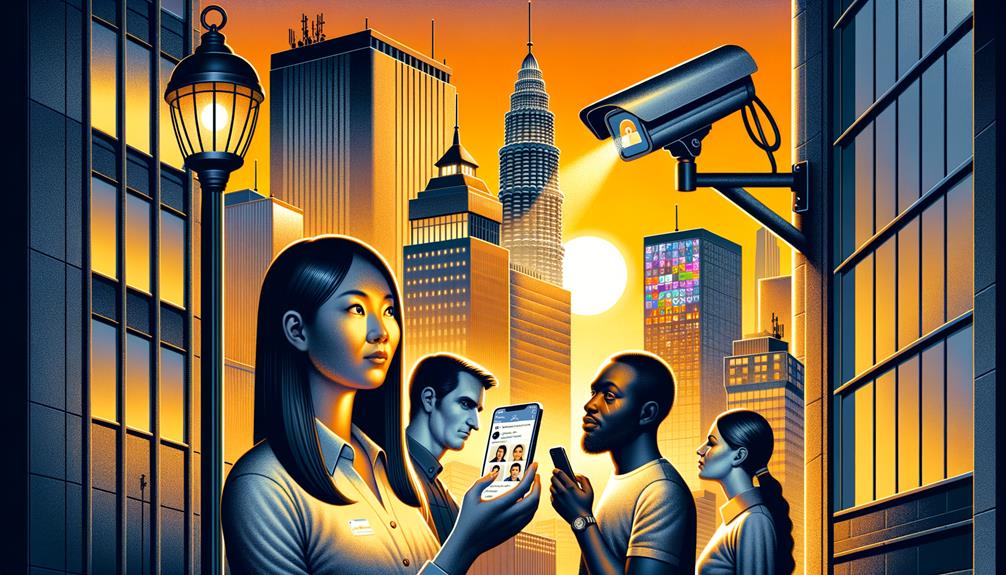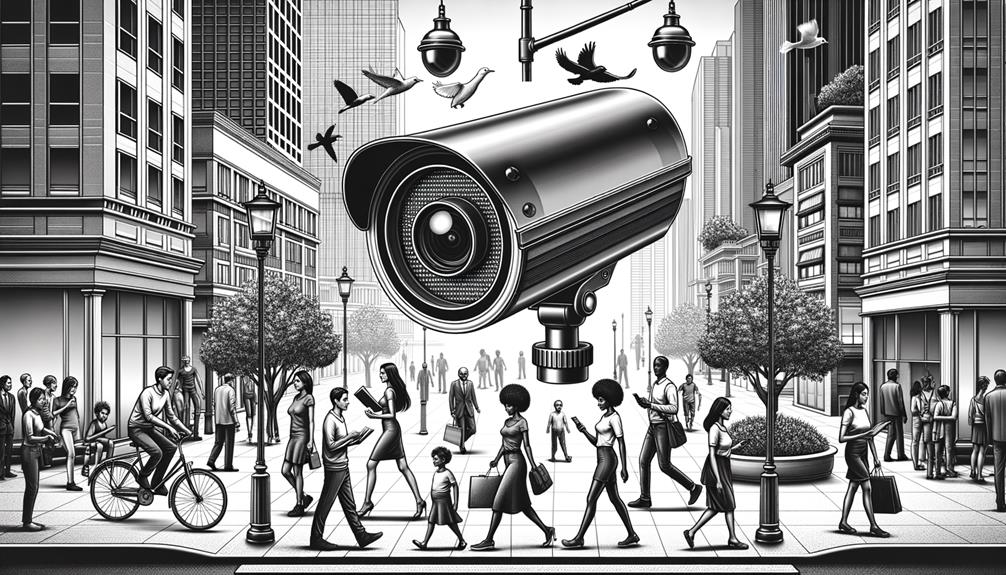I know facial recognition technology's role in surveillance is vital yet unsettling. It fosters clandestine mass monitoring without individual consent, compromising privacy and freedom. This technology can be used to track our movements and activities unseen, and its biases follow the already unfair lines of systemic racism. Facial recognition surveillance could turn cities into digital panopticons, where we lose control over our personal information. But are we willing to challenge these practices and seek a more secure digital landscape?
Key Takeaways
- Facial recognition technology enables widespread, intrusive surveillance without user consent.
- Error rates in facial recognition systems are disproportionately high for marginalized communities.
- Scrutiny and regulation are essential to safeguard civil liberties and privacy rights.
- Biases in facial recognition contribute to discrimination and unfair profiling in law enforcement.
- Regulatory efforts, like local bans, reflect growing concerns about the technology's misuse.
Surveillance and Facial Recognition
In the digital era, facial recognition and surveillance have intertwined to create a pervasive threat to privacy. Technologies are capable of covert identification on a mass scale without consent, threatening our fundamental rights and fostering environments of control and marginalization.
Imagine a world where your face becomes an unwitting identifier, perpetually surveilled and monitored by both government and private entities. This dystopian reality is being shaped by facial recognition software, aggressively utilized by local law enforcement and the public sector to facilitate mass surveillance.
The invasive nature of facial recognition technology is rightfully sparking concerns about privacy law and the sinister implication of racial profiling. Alarmingly, facial recognition systems often exhibit higher error rates when identifying individuals from marginalized communities, leading to unfair arrests and perpetuating systemic discrimination.
The proliferation of facial recognition technology has far-reaching consequences, and it's our responsibility to scrutinize and regulate its use. We must ensure that our civil liberties aren't sacrificed at the altar of security.
Technology Behind Facial Recognition
Facial recognition technology operates by capturing digital images or video frames that include faces, which are then meticulously analyzed using sophisticated algorithms to identify an individual. These algorithms, such as GaussianFace and FaceNet, are the backbone of facial recognition and play an essential role in identifying people accurately.
However, error rates in facial recognition systems are still high, with companies like Amazon facing criticism over their technology's bias towards darker-skinned women. For instance, Amazon's Rekognition service falsely identified 28 US Congress members as individuals arrested for crimes, highlighting the importance of unbiased algorithms in surveillance technology.
Recent tests demonstrated by the National Institute of Standards and Technology (NIST) underscore the need for accurate facial recognition technology. The NIST Ongoing Face Recognition Vendor Test (FRVT) 3 revealed that the best algorithms have no racial or sex bias, emphasizing the significance of unbiased technology.
These results are critical in ensuring that surveillance technology serves the greater good without perpetuating discrimination.
Privacy Laws and Protections

Protecting privacy rights in the face of increasingly pervasive surveillance technologies remains a pressing concern, and federal agencies must strengthen safeguards for facial recognition use in law enforcement. Ensuring that privacy laws keep pace with advancements in facial recognition technology is vital.
Recent state-level privacy laws, such as those in California, Colorado, and Virginia, provide residents with necessary rights to access and delete personal information, including biometric data collected through facial recognition. Importantly, major companies like Amazon, Microsoft, and IBM have pledged to limit facial recognition sales to law enforcement, recognizing that these technologies can be used for unintended surveillance and discrimination.
To address privacy concerns, proposals emphasize the need for clear restrictions on surveillance technologies and increased training for law enforcement to prevent unfair profiling. Implementing robust oversight mechanisms and strengthening federal privacy protections with proscriptive guardrails are essential steps towards responsible facial recognition deployment.
It's time for policymakers to reevaluate existing privacy safeguards and identify areas for enhancement to effectively address ongoing privacy concerns.
Applications in Law Enforcement
With the necessity to enhance privacy safeguards in place, the seemingly camouflaged role of facial recognition technology in law enforcement practices warrants increased scrutiny and transparency.
The widespread use of facial recognition by federal and local agencies highlights serious concerns about potential bias in policing practices. Approximately 20 of 42 federal agencies utilize this technology, as do one out of four state and local agencies. Moreover, companies like Clearview AI, which has partnered with over 3,100 agencies, are major providers of facial recognition tools.
These systems often have higher misidentification rates for communities of color, contributing to unfair profiling and reinforcing biases in law enforcement actions. As facial recognition technology continues to be embedded in surveillance methods, it's essential to acknowledge and address these inherent biases that can have significant impacts on communities already subject to disproportionate policing.
Clear regulations, robust training, and comprehensive policies are necessary to guarantee that the data and technology used don't perpetuate discrimination.
Ethical Implications and Risks

Two critical ethical implications of facial recognition in surveillance behavior are the potential for mass privacy invasion and the significant risk of biased profiling, particularly for communities of color. As this technology is integrated into illicit surveillance practices, individuals lose control over their personal information and are subject to constant detection, even when not suspecting any wrongdoing.
The bigger issue lies in the starkly different misidentification rates faced by communities of color, which often results in unfair targeting, reinforcing existing racial and social biases. What's more, the inaccuracies in facial recognition can lead to false positives, leading to incorrect arrests and further undermining trust in law enforcement.
Additionally, individuals are stripped of the right to maintain anonymity and aren't given meaningful choices to conceal their faces, raising concerns about tracking and profiling. In response, regulatory efforts such as local bans and moratoria are underway, reflecting growing unease about the misuse of this technology.
Frequently Asked Questions
What Is the Role of Facial Recognition System in Surveillance Systems?
I'm extremely concerned about facial recognition systems, which compromise privacy due to high false positive rates among particular demographics and lack of data protection. Government and commercial uses often disregard ethical implications and public acceptance, highlighting the need for stricter legal regulations on facial databases.
How Does Facial Recognition Help With Security?
I believe facial recognition helps with security by enabling biometric identification, enhancing crime prevention, and control through access management. This technology facilitates real-time tracking and facial analysis to verify identities and prevent unauthorized access, which boosts law enforcement efforts and overall security while raising privacy-and-data-protection concerns.
What Is the Difference Between Facial Recognition and Face Surveillance?
"I distinguish facial recognition from face surveillance by understanding the purpose and scope. Recognition aims at verification, while surveillance involves broad, often privacy-invading tracking, raising ethical and consent concerns."
What Is Recognition in Surveillance?
"I emphasize that recognition in surveillance is risky due to analyzes facial features without consent, reinforcing privacy concerns around biometric data. It raises ethical implications and significant questions about law enforcement, public safety, and effective data protection."









